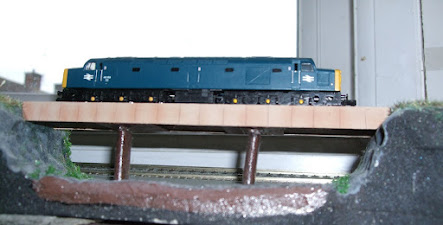Manufacture - Graham Farish [Cat no - 371-178A]
Graham Farish (Poole) Class 40 fitted with later body, numbered 40150, in BR Blue livery with nicely detailed bodywork and all buffers, couplings intact.
Purchased unboxed it arrived in good condition although it was apparent that the bodywork was slightly loose, suggesting to me that it was perhaps a new body on an older chassis. Wasn't a problem as purchased for a bargain price. Began life with us as a slow runner and didn't seem to enjoy the bends of my Kato test track, that's when I notice the body being loose and decided to take it apart for a closer look. Given a good inspection, cleaned and lightly oiled up, was pleased to see it taken back to my test track for an hour of slow but ideal running.
Head codes
Carries a four box head code block with the numbered end ['Front'] showing - IF 95 while the 'Rear' shows - IF 89.
BR CLASS 40
Locomotives in the range D210–D235 were to be named after ships operated by the companies Cunard Line, Elder Dempster Lines, and Canadian Pacific Steamships, as they hauled express trains to Liverpool, the home port of these companies. The only locomotive not to carry a name was D226 which was to carry the name Media but never did so. From approximately 1970, with Class 40s no longer working these trains, the nameplates were gradually removed. A series of unofficial names were applied to the Class 40s by enthusiasts and enthusiastic depot staff. Some locos ran in service with these names applied for many months, others were painted out within days.
This included my model which according to my limited research 40150 would have carried the unofficial name of 'Crewe'. Our model would have been withdrawn as part of the final batch in 1985 and scrapped.
Class 40 Background
The British Rail Class 40 is a type of British railway diesel electric locomotive. A total of 200 were built by English Electric between 1958 and 1962. They were originally numbered D200-D399. They were, for a time, the pride of British Rail’s early diesel fleet. However, despite their initial success, by the time the last examples were entering service they were already being replaced on some top-level duties by more powerful locomotives. As they were slowly relegated from express passenger uses, the type found work on secondary passenger and freight services where they worked for many years. The final locomotives ended regular service in 1985.
Class 40 in Preservation
Seven locomotives and one cab end (40 088) have been preserved on heritage railways, including the first built, number D200, and the Departmental Locomotives, 97 406, 97 407, 97 408. Of the seven class 40's to be preserved all except for 40118 have run in preservation and three have run on the main line in preservation, these being Nos D200 (40122), D213 (40013) and D345 (40145).
One of them, No. 40013 Andania (pictured above) was rescued from Vic Berry's Scrapyard in 1987.[36] D212 Aureol was briefly sent to Vic Berry's Scrapyard for asbestos removal before being moved to its new home at the Midland Railway Centre.
The original build D200 is part of the National Collection and displayed at York NRM (pictured below). Only two have Mainline registration D213 (LSL Diesel Fleet) and D345 (40 145) which is one of three owned by the Class 40 Preservation Society.






No comments:
Post a Comment